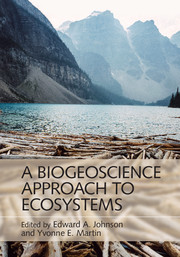Book contents
- Frontmatter
- Contents
- List of contributors
- Preface
- Miscellaneous Frontmatter
- 1 Introduction
- Part I Connecting Ecosystem and Geoscience Processes
- Part II Transport Processes and Conservation Budgets in Biogeoscience
- Part III Coupling Hillslope Geomorphology, Soils, Hydrology, and Ecosystems
- Part IV Coupling Fluvial and Aeolian Geomorphology, Hydrology/Hydraulics, and Ecosystems
- 10 Mechanisms of Flow and Sediment Transport in Fluvial Ecosystems: Physical and Ecological Consequences
- 11 Measuring the Hydraulic Landscapes of Stream-Dwelling Invertebrates for Ecological Research
- 12 Salt Marsh Ecosystems: Tidal Flow, Vegetation, and Carbon Dynamics
- 13 Coastal Dunes and Vegetation Dynamics
- 14 Biogeomorphic Ecosystems within Stressful and Disturbed Environments: A Focus on Termites and Pioneer Plants
- Index
- References
11 - Measuring the Hydraulic Landscapes of Stream-Dwelling Invertebrates for Ecological Research
from Part IV - Coupling Fluvial and Aeolian Geomorphology, Hydrology/Hydraulics, and Ecosystems
Published online by Cambridge University Press: 27 October 2016
- Frontmatter
- Contents
- List of contributors
- Preface
- Miscellaneous Frontmatter
- 1 Introduction
- Part I Connecting Ecosystem and Geoscience Processes
- Part II Transport Processes and Conservation Budgets in Biogeoscience
- Part III Coupling Hillslope Geomorphology, Soils, Hydrology, and Ecosystems
- Part IV Coupling Fluvial and Aeolian Geomorphology, Hydrology/Hydraulics, and Ecosystems
- 10 Mechanisms of Flow and Sediment Transport in Fluvial Ecosystems: Physical and Ecological Consequences
- 11 Measuring the Hydraulic Landscapes of Stream-Dwelling Invertebrates for Ecological Research
- 12 Salt Marsh Ecosystems: Tidal Flow, Vegetation, and Carbon Dynamics
- 13 Coastal Dunes and Vegetation Dynamics
- 14 Biogeomorphic Ecosystems within Stressful and Disturbed Environments: A Focus on Termites and Pioneer Plants
- Index
- References
Summary
Introduction
The ecology of stream organisms can be influenced in diverse ways by the forces of flowing water. Recent decades have seen a growing interest in ecological research at this biological–physical interface. Much of that work has focused on benthic macroinvertebrates (approximately >1 mm in size), which live at the sediment surface and are the dominant macrofauna in most riverine systems. Research at this interface needs to be well grounded in ecological theory (Lancaster and Downes, 2010a, 2010b), but also in an accurate depiction and understanding of the physical environment (Rice et al., 2010), with particular attention on the local scales at which invertebrates respond to flow. Flow can have diverse direct and indirect effects on invertebrates, such as influencing their performance, ability to move (disperse) or maintain position, habitat characteristics, behavior, resource acquisition (feeding), competition, predation and population persistence (see review, Hart and Finelli, 1999), which in turn can influence various ecosystem processes. Concurrently, the activities of stream-dwelling organisms themselves can alter local flows, sediment characteristics and bedforms, which may create positive or negative feedback loops in ecological processes. It follows, logically, that it is impossible to predict ecological events solely from a description of the physical habitat (Belyea and Lancaster, 1999). Similarly, many variables used to describe the physical habitat may provide no insight into ecological processes. Disentangling these complex interactions, which occur over a range of spatial and temporal scales, is an enduring but fascinating challenge.
The aim of this chapter is to review some features of the hydraulic landscape in which macroinvertebrates live, and in a way that is relevant to the biology and ecology of invertebrates. This discussion is loosely targeted at an audience interested in working on ecological questions about stream invertebrates, and that have a broad understanding of ecology and invertebrate biology, but that may lack a strong background in the physical sciences. Ecological issues per se will not be discussed; instead the focus is on aspects of the local flow environment experienced by macroinverterbates and that researchers may wish to measure when addressing ecological questions. A very wide array of ecological questions fall under the umbrella of biophysical coupling (see review by Hart and Finelli, 1999) and, unfortunately, there are no simple recipes or even clear guidelines of what to measure when tackling particular ecological questions.
- Type
- Chapter
- Information
- A Biogeoscience Approach to Ecosystems , pp. 383 - 406Publisher: Cambridge University PressPrint publication year: 2016
References
- 1
- Cited by

